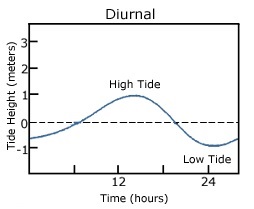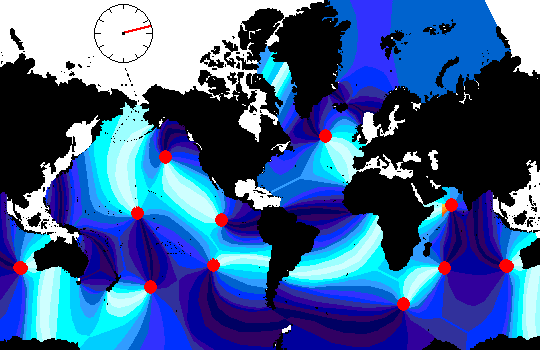Before the development of appropriate instrumentation, sea-level observations were confined to the coast and were not very accurate. The tidal responses of the ocean to the forcing of the Moon and Sun are very complicated and tidal features vary greatly from one site to another. Lets get into the basics first.
Tides are the periodic raising and lowering of average sea level that occurs throughout the ocean.
In other we can say:
Tides are the periodic motion of the waters of the sea due to changes in the attractive forces of the Moon and Sun upon the rotating Earth.
Major difference between tide and current:
The rise and fall of tide is accompanied by horizontal movement of the water called tidal current. It is necessary to distinguish clearly between tide and tidal current, for the relation between them is complex and variable.
For the sake of clarity mariners have adopted the following definitions:
Tide is the vertical rise and fall of the water, and tidal current is the horizontal flow.
The tide rises and falls, the tidal current floods and ebbs. The navigator is concerned with the amount and time of the tide, as it affects access to shallow ports.
Tides are superimposed on non tidal rising and falling water levels, caused by weather, seismic events, or other natural force. Similarly,Tidal currents are superimposed upon non-tidal currents such as normal river flows, floods, and freshets
Cause of tides:
The gravitational attraction of the Sun and Moon on Earth creates ocean tides. In a more complete analysis, tides are generated by forces imposed on Earth that are caused by a combination of gravity and motion among Earth, the Moon, and the Sun.
The principal tidal forces are generated by the Moon and Sun. The Moon is the main tide-generating body. Due to its greater distance, the Sun’s effect is only 46 percent of the Moon’s. Observed tides will differ considerably from the tides predicted by equilibrium theory since size, depth, and configuration of the basin or waterway, friction, land masses, inertia of water masses, Coriolis acceleration, and other factors are neglected in this theory.
Nevertheless, equilibrium theory is sufficient to describe the magnitude and distribution of the main tide-generating forces across the surface of the Earth
At most places the tidal change occurs twice daily. The tide rises until it reaches a maximum height, called high tide or high water, and then falls to a minimum level called low tide or low water.
The rate of rise and fall is not uniform. From low water, the tide begins to rise slowly at first, but at an increasing rate until it is about halfway to high water. The rate of rise then decreases until high water is reached, and the rise ceases.
The difference in height between consecutive high and low waters is the range.
Priming and lagging :
With the Moon in positions between quadrature and new or full, the effect of the Sun is to cause the tidal bulge to either lag or precede the Moon. These effects are called priming and lagging the tides.
Types of tide:
Diurnal Tide
A diurnal tidal pattern has a single high and low tide each lunar day. These tides are common in shallow inland seas such as the Gulf of Mexico and along the coast of Southeast Asia. Diurnal tides have a tidal period of 24 hours 50 minutes.



